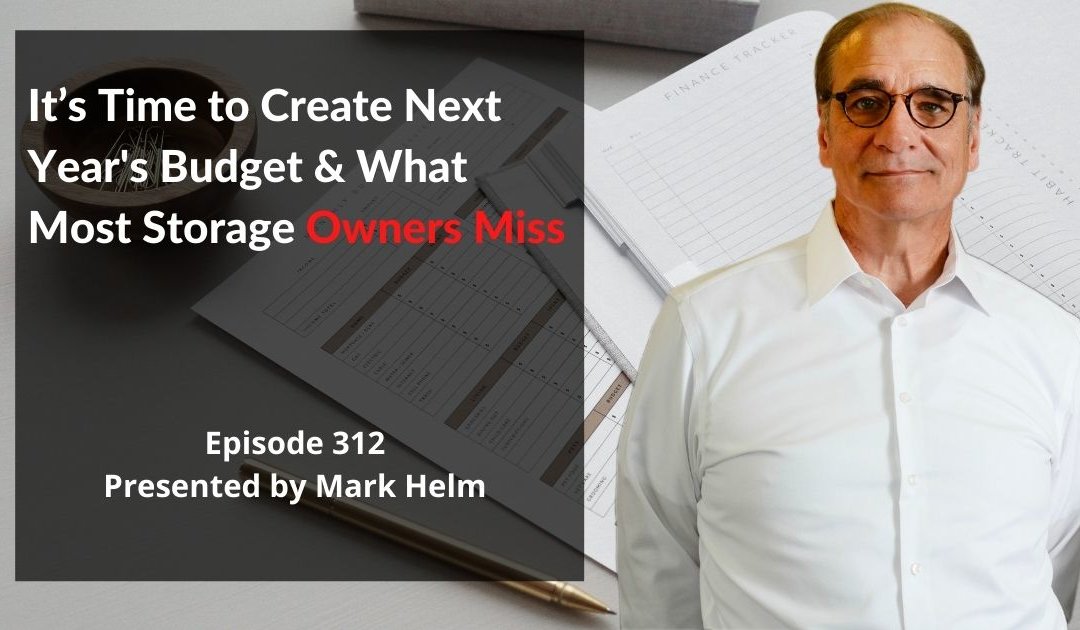It’s that time of year. It’s time to begin creating your 2022 self storage operating budget.
I want to take a slightly different approach than most people.
There are a lot of good articles out there on how to create a budget. I would rather focus on a couple of things most Owners miss that can make the difference.
What Is A Budget
First of all, like most important things in life, let’s start with a mindset change.
Most people, if pressed, especially third-party managers, relate to a budget something like this:
“A budget is our prediction of what this storage facility is going to do this calendar year.”
Valid, but it could be something different, something more.
What if, instead of a “prediction,” budgets, to a large degree, could become a “creation” of what is going to happen next year.
Here is one way that could look. One of our KPI’s (key performance indicators) we use to measure managers (and ourselves) is retail sales per move-in.
Sometimes we sit with managers; and ask them what is needed to move the needle on this. How can we go from, let’s say, $22 per move-in on average to $28.50 per move-in on average in the upcoming year?
We listen, then support the manager in creating the new game, which becomes part of our new budget.
Or what new income stream can we add?
Or a new retail item to sell?
You can do the same with expenses. Create new ways to run the business reducing the expenses you can because some have gone up, like marketing and property taxes.
In my opinion, all success, including setting operating budgets, starts with a different mindset than most people bring to the table.
The Real Secret To Creating Wealth Using Operating Budgets
But the biggest and single most important item needed to create ongoing wealth using self storage is the one most often missed when setting up an operating budget.
Mostly, budgets are created by looking at the previous year, then making adjustments in income and expenses to “improve” the financial condition this year.
Again, valid, but it misses what I think is the most important aspect of wealth creation. That is why, as an owner, you are in self storage in the first place.
If I ask you this question, be honest.
“Do you know how much your income increased (or decreased) last year over your operating expenses, and what increase this year you need (income growth over operating expense growth) to be on target for the 10-year Proforma you created when you put this deal into service?”
Now you may say, “I didn’t create a 10-year pro forma when I bought or built this project.
But most people do. You needed to do something to determine if it was a good deal. The bank most likely did, and if you obtained a feasibility report, they most likely did also.
So, I bet you have one, somewhere if you are not present to it.
But I am present to ours, and I know where we are in relationship to it.
Why?
Because the growth of income over expenses compounds over time, and nothing, I mean nothing, creates the wealth in self storage like that growth.
In all our pro forma statements, we usually have income growing only one-half of one percent average over our operating expenses every year. But that one-half of one percent creates millions of dollars over a ten-year period.
Here is an example.

Now in this example, see the NOI going up each year?
The only action happening on this entire pro forma is the income is going up 3% per year, and the operating expenses are going up at 2.5% per year. The is the half a percent income growth I was talking about.
Look at how most wealth is created in a decade. I assumed a 7% CAP rate to determine yearly values (highlighted in yellow).
The value goes from $8.9 million in year 2 to just under $12 million in year 10.
That is with only one-half of one percent average income growth over operating expenses. In reality, it is usually closer to 2% or 3% on average per year over a longer period. Remember, you are never locked into long-term rental rates in self storage. You can change them daily if you wish.
This is where real wealth is created in this asset class. There are so few variables hitting the NOI line or below the debt service line. A slight reserve fund usually covers any and all capital expenses in the ten-year time frame.
So, I ask you again, how much increase as a percentage was your income over operating expenses last year and what are you creating this year?



